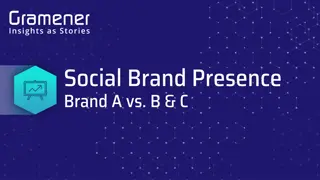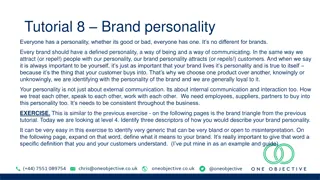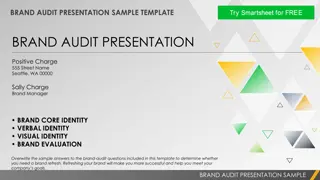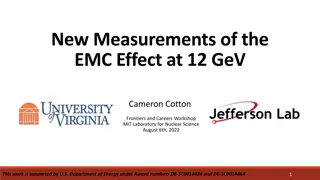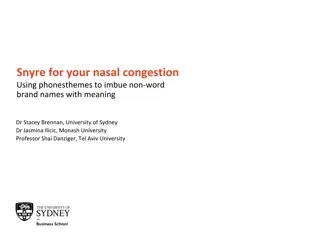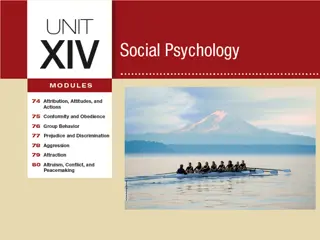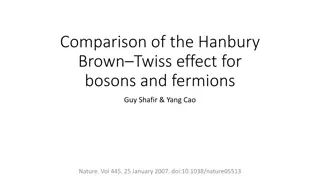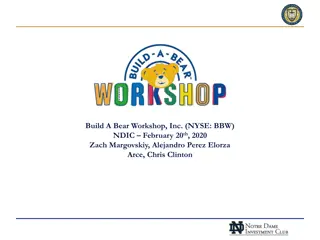Understanding the Spotlight Effect in Brand Customization
Exploring how brand customization influences consumer behavior through the spotlight effect, which involves individuals overestimating the attention others pay to their possessions. This analysis focuses on the impact of customization on willingness to pay, uniqueness perception, and luxury vs. non-luxury brand categories. The study delves into the cognitive biases and psychological mechanisms underlying consumer responses to personalized products in the participation economy.
Download Presentation

Please find below an Image/Link to download the presentation.
The content on the website is provided AS IS for your information and personal use only. It may not be sold, licensed, or shared on other websites without obtaining consent from the author. Download presentation by click this link. If you encounter any issues during the download, it is possible that the publisher has removed the file from their server.
E N D
Presentation Transcript
I LOVE UNIQUENESS! I WILL PAY THE PRICE! Saeedeh Vessal Haithem Guizani PierreValette-Florence
HOW BRAND CUSTOMIZATION CAUSES HIGHER WILLINGNESS TO PAY THROUGH SPOTLIGHT EFFECT I BUILD IT
SPOTLIGHT EFFECT? Social comparison theory/ symbolic interactionism/ symbolic power (soft power) (Festinger, 1945; Goffman, 1982; Bourdieu, 1980) Cognitive bias ( False consensus effect): people s tendency to overestimate the degree to which others share their attitudes and traits (Ross at al., 1977). Gilovich and Savitsky (1999, 2000)): the phenomenon in which people tend to believe they are noticed more than they really are. Objective: to study spotlight effect within consumer behavior and brand value perception.
SPOTLIGHT PHENOMENA WITHIN THE SPECIFIC CASE OF BRAND CUSTOMIZATION As moved to participation economy, firms get involved in products personalization (co-creation, community, creativity .): and behavioral dimensions (WTP) connection, sharing Need of maintaining uniqueness (Snyder and Fromkin,1980). How people's beliefs about the degree to which they are noticed by others can affect their brand value perception (Wind and Rangaswamy, 2001; Schreier2006; Lynn and Harris 1997). To what extend customization will have positive effect on willingness to pay? The process?
MODEL AND HYPOTHESES Encouraging customers feeling of uniqueness and giving them the ability to change the shape of an object (cognitive effort, feeling of control ) through customization increases their overestimation of others attention to their possession and consequently on their willingness to pay (Franke and Schreier, 2008) Does product category and brand name (luxury vs. Non-luxury) has a moderating role on the relation between mass customization and the spotlight effect. Does the customized features types are relevant? ( hedonic vs utilitarian) (Hirschman and Holbrook 1982) The more the merrier : choice difficulty effect (Wang, 2010)
MODEL AND HYPOTHESES Luxurious vs. non-luxurious Choice difficulty H4 H2 Spotlight effect Product customization Willingness to pay H1 H3 MC features (hedonic vs. utilitarian)
97 110 STUDIES Study 1: mediating effect Gilovich et al. (2000), we asked participants about their perception of others awareness about their possessions (e.g. if YOU wear this product' how many percentage of your classmates will notice it? If someone of you classmate wear this product' how many percentage of your classmates will notice it ). Study 2: Brand category Luxury vs ordinary watch ( brand name) Study3: Hedonic vs utilitarian features face color, straps color and frame color VS water resistant, movement, case diameter etc. Online customization Study 4: choice difficulty Choosing 4 features among many others, personalize, choosing 4 characters to engrave into the product. How difficult was choosing this product for you
RESULTS: STUDY 1 Multiple regression analysis results , N=54 Values T (53) 2.20 5.29 8.77 Results B 1.58 2.37 1.24 P 0.03 0.00 0.00 MC positively related to WTP MC positively related to SE SE positively related to WTP Mediation analysis results Values B - -1.36 Results CI T - -1.23 P - 0.01 SE mediates MC and WTP relation Direct effect of MC on WTP 1.82 to 4.27
RESULTS: STUDY 2 Existing conflict in past studies: Willingness to pay is not higher for customized products (Schreier, 2006). consumers are willing to pay a slightly premium price for a self- designed product (Franke and Piller,2004). 2X 2 Between subjects : Main effect of Brand name ((F(1, 88))=20.75; p=0.00) but no interaction (F=3.31; p>0.05) 7 6 MC Non MC 5 Level of SE 4 3 2 1 0 Lux Non lux MC ability, product categories and SE
RESULTS: STUDY 3 Luxury: the ratio of functionality to price is low, while the ratio of intangible and situational utility to price is high (Nueno and Quelch,1998). Does appearance customization features reinforce the mediation effect of spotlight effect compared to functional customization features? Confirm the luxury brand effect([F (1, 56) =14.99; p=0.00]) Interaction effect between luxury and features ([F (1, 56) =8.19; p=0.01]) 8 Hedonic Utilitarian 7 6 Level of SE 5 4 3 2 1 0 Lux Non lux MC ability, product categories and SE
DISCUSSION AND CONCLUSION Partially confirm Franke and Schreier s (2008) results Customization is an efficient marketing tool to enhance consumer intention to pay the premium price. Customization is positively associated with SE level and indirectly impacts WTP. Customization is important for both luxury and non-luxury products. Two dimensions of SE: symbolic interactionist values and efficiency, expertise( Holbrook?) Participants in the luxury type were more interested in personalizing hedonic features. Co-value creation in both aesthetic and efficient. Increasing the number of choices in the customization Increasing spotlight effect s level Negative direct effect on the level of the WTP.
LIMITATIONS AND FUTURE RESEARCH Investigate the spotlight process ( pride, overconfidence, relationship reciprocity) Measure others perception of self designed product in lab conditions ( comparison with the real perception ) Non linear relationship between MC and WTP (through SE) Controlling tolerance of ambiguity ( Budner, 1962) (study 4: see the paper) As managerial implication: simple and easy design , hedonic features for luxury products.




